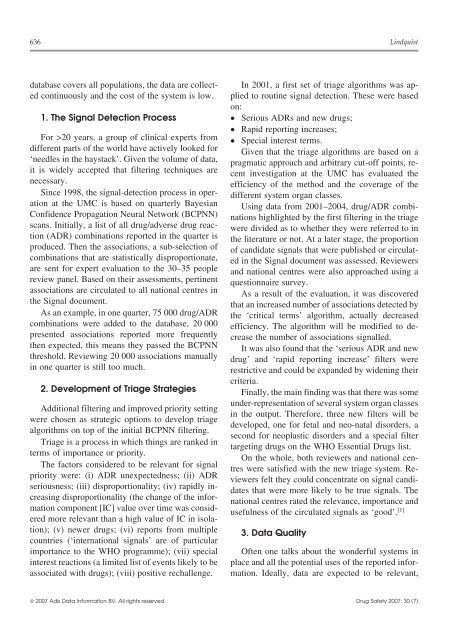View - Uppsala Monitoring Centre
View - Uppsala Monitoring Centre
View - Uppsala Monitoring Centre
Create successful ePaper yourself
Turn your PDF publications into a flip-book with our unique Google optimized e-Paper software.
636 Lindquistdatabase covers all populations, the data are collect- In 2001, a first set of triage algorithms was apedcontinuously and the cost of the system is low. plied to routine signal detection. These were basedon:1. The Signal Detection Process • Serious ADRs and new drugs;• Rapid reporting increases;For >20 years, a group of clinical experts from • Special interest terms.different parts of the world have actively looked for Given that the triage algorithms are based on a‘needles in the haystack’. Given the volume of data, pragmatic approach and arbitrary cut-off points, reitis widely accepted that filtering techniques are cent investigation at the UMC has evaluated thenecessary.efficiency of the method and the coverage of theSince 1998, the signal-detection process in oper- different system organ classes.ation at the UMC is based on quarterly Bayesian Using data from 2001–2004, drug/ADR combi-Confidence Propagation Neural Network (BCPNN) nations highlighted by the first filtering in the triagescans. Initially, a list of all drug/adverse drug reac- were divided as to whether they were referred to intion (ADR) combinations reported in the quarter is the literature or not. At a later stage, the proportionproduced. Then the associations, a sub-selection of of candidate signals that were published or circulatcombinationsthat are statistically disproportionate, ed in the Signal document was assessed. Reviewersare sent for expert evaluation to the 30–35 people and national centres were also approached using areview panel. Based on their assessments, pertinent questionnaire survey.associations are circulated to all national centres in As a result of the evaluation, it was discoveredthe Signal document.that an increased number of associations detected byAs an example, in one quarter, 75 000 drug/ADR the ‘critical terms’ algorithm, actually decreasedcombinations were added to the database, 20 000 efficiency. The algorithm will be modified to depresentedassociations reported more frequently crease the number of associations signalled.then expected, this means they passed the BCPNN It was also found that the ‘serious ADR and newthreshold. Reviewing 20 000 associations manually drug’ and ‘rapid reporting increase’ filters werein one quarter is still too much.restrictive and could be expanded by widening theircriteria.2. Development of Triage Strategies Finally, the main finding was that there was someunder-representation of several system organ classesAdditional filtering and improved priority settingin the output. Therefore, three new filters will bewere chosen as strategic options to develop triagedeveloped, one for fetal and neo-natal disorders, aalgorithms on top of the initial BCPNN filtering.second for neoplastic disorders and a special filterTriage is a process in which things are ranked intargeting drugs on the WHO Essential Drugs list.terms of importance or priority.On the whole, both reviewers and national cen-The factors considered to be relevant for signaltres were satisfied with the new triage system. Reprioritywere: (i) ADR unexpectedness; (ii) ADRviewers felt they could concentrate on signal candiseriousness;(iii) disproportionality; (iv) rapidly indatesthat were more likely to be true signals. Thecreasing disproportionality (the change of the infornationalcentres rated the relevance, importance andmation component [IC] value over time was considusefulnessof the circulated signals as ‘good’. [1]ered more relevant than a high value of IC in isolation);(v) newer drugs; (vi) reports from multiplecountries (‘international signals’ are of particular3. Data Qualityimportance to the WHO programme); (vii) special Often one talks about the wonderful systems ininterest reactions (a limited list of events likely to be place and all the potential uses of the reported inforassociatedwith drugs); (viii) positive rechallenge. mation. Ideally, data are expected to be relevant,© 2007 Adis Data Information BV. All rights reserved. Drug Safety 2007; 30 (7)
















